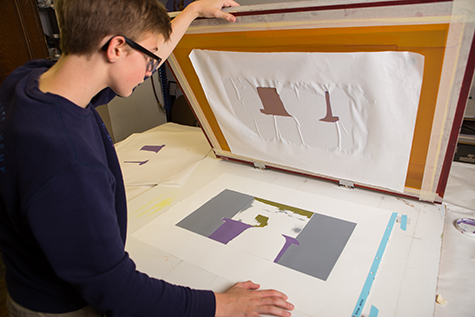The Crucial Overview to Recognizing Screen Printing and Its Versatile Makes use of
Screen printing has an abundant background that dates back to ancient times, progressing right into an advanced technique made use of across various markets today. This overview explores the details of the screen printing process, outlining its applications in home, advertising and marketing, and style décor - 10:9 Design Embroidery. Recognizing these fundamentals can open up creative potential for both commercial and imaginative tasks. The following sections will certainly expose essential ideas and methods to enhance one's screen printing undertakings
The Background of Screen Printing
Screen printing has origins that map back centuries, its development mirrors the technological and creative advancements of numerous cultures. Originating in old China, the method was initially used for decorating fabrics and later spread to Japan, where it ended up being important to Ukiyo-e woodblock printing. The method moved to Europe in the 18th century, where it obtained popularity among artisans and business printers. The development of picture solution in the 20th century changed screen printing, allowing for more elaborate styles and better performance. Artists like Andy Warhol further pushed its popularity, making use of the tool to develop renowned works that blended commercialism and art. By the late 20th century, screen printing had established itself as a flexible technique, employed in style, marketing, and art. Today, it remains to evolve, integrating electronic modern technology and expanding its applications across different industries.
The Screen Printing Refine Explained
Screen printing transforms artistic visions right into concrete designs through a series of precise steps. Originally, an image is created and after that transferred onto a screen, usually made from fine mesh textile extended over a structure. A light-sensitive solution is used to the screen, which is subjected to light, hardening in locations not covered by the photo. After cleaning out the unhardened emulsion, a stencil is created.
Next off, the screen is positioned over the substratum, whether it be material, paper, or an additional material. Ink is then pushed with the open locations of the pattern making use of a squeegee, depositing the design onto the substrate listed below. This process can be duplicated for multiple colors, requiring separate displays for every tone. The published product is healed making use of heat to ensure the ink sticks effectively, resulting in a sturdy, dynamic layout ready for usage.
Kinds of Screen Printing Techniques

Furthermore, specialty methods, such as discharge screen printing, remove color from the fabric to create softer prints, while aluminum foil screen printing applies metallic aluminum foil to achieve a glossy finish (10:9 Design Company). Each technique supplies unique characteristics, catering to numerous innovative demands and manufacturing ranges, eventually increasing the possibilities within the screen printing domain
Applications of Screen Printing in Different Industries
In addition, the signs and advertising and marketing markets use screen printing for producing attractive displays and banners. This method allows for bold colors and detailed styles that capture focus. In electronics, screen printing is employed for using conductive inks to motherboard, essential for part links. Additionally, the home style market accepts screen printing to create distinctive layouts on fabrics and wall art. Generally, screen printing acts as a critical device throughout diverse areas, enhancing items with personalized and aesthetically attractive graphics.
Tips for Effective Screen Printing Projects
While carrying out a screen printing task, mindful attention to information can considerably boost the last result. Choosing high-quality products is necessary; this consists of the screen, inks, and substrates. Utilizing suitable mesh counts can impact ink deposition and detail resolution. this content Preparation is similarly important; comprehensive cleansing of screens and proper direct exposure times guarantee crisp prints.
Next, exact registration is crucial for multi-color prints. Making use of positioning devices can assist accomplish precise layering. Additionally, screening prints on scrap products before production aids recognize prospective issues without wasting sources.

Regularly Asked Inquiries
What Materials Are Finest for Screen Printing on Textile?
Cotton and polyester blends are excellent for screen printing on textile as a result of their durability and ink absorption. Additionally, specialty materials like silk or canvas can create one-of-a-kind appearances and coatings, enhancing the overall layout top quality.
Just how Do I Clean and Maintain Screen Printing Devices?
To maintain and clean screen printing tools, one need to consistently clean displays with appropriate solvents, examine mops for wear, lubricate relocating components, and store all items in a completely dry, dust-free setting to extend their life expectancy.
What Are the Environmental Influences of Screen Printing?
Screen printing can have substantial environmental impacts, consisting of chemical waste from solvents and inks, water usage throughout cleansing processes, and power usage. Sustainable techniques and green materials are crucial for lessening these negative results.
Can Screen Printing Be Done in your home Efficiently?
Screen printing can be effectively done at home with the ideal materials and methods. Enthusiasts can create top quality prints, though success depends upon their ability level, tools, and understanding of the process entailed.
What Are the Expenses Connected With Starting a Display Printing Company?

Beginning a screen printing organization involves expenses for equipment, products, and work area. Preliminary expenditures generally vary from a couple of hundred to numerous thousand dollars, depending upon the range, top quality of equipment, and desired production capability.
Screen printing has an abundant background that dates back to old times, advancing right into an innovative strategy used across various markets today. One more method, rotating screen printing, employs round screens, promoting continual printing on fabric rolls, therefore boosting efficiency for large-scale productions. Additionally, specialty techniques, such as discharge screen printing, remove color from the material to produce softer prints, while foil screen printing applies metallic foil to achieve a shiny finish. In the fashion sector, screen printing is extensively made use of to develop vivid layouts on clothing, allowing brands to showcase their distinct designs. Cotton This Site and polyester blends are excellent for screen printing on material due to their toughness and ink absorption.